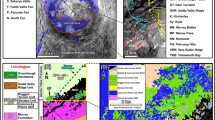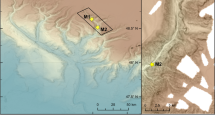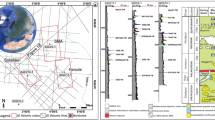Abstract
Submarine landslides can generate sediment-laden flows whose scale is impressive. Individual flow deposits have been mapped that extend for 1,500 km offshore from northwest Africa1,2,3,4,5,6,7. These are the longest run-out sediment density flow deposits yet documented on Earth. This contribution analyses one of these deposits, which contains ten times the mass of sediment transported annually by all of the world’s rivers8. Understanding how this type of submarine flow evolves is a significant problem, because they are extremely difficult to monitor directly9. Previous work has shown how progressive disintegration of landslide blocks can generate debris flow, the deposit of which extends downslope from the original landslide10,11,12,13. We provide evidence that submarine flows can produce giant debris flow deposits that start several hundred kilometres from the original landslide, encased within deposits of a more dilute flow type called turbidity current. Very little sediment was deposited across the intervening large expanse of sea floor, where the flow was locally very erosive. Sediment deposition was finally triggered by a remarkably small but abrupt decrease in sea-floor gradient from 0.05° to 0.01°. This debris flow was probably generated by flow transformation from the decelerating turbidity current. The alternative is that non-channelized debris flow left almost no trace of its passage across one hundred kilometres of flat (0.2° to 0.05°) sea floor. Our work shows that initially well-mixed and highly erosive submarine flows can produce extensive debris flow deposits beyond subtle slope breaks located far out in the deep ocean.
This is a preview of subscription content, access via your institution
Access options
Subscribe to this journal
Receive 51 print issues and online access
$199.00 per year
only $3.90 per issue
Buy this article
- Purchase on Springer Link
- Instant access to full article PDF
Prices may be subject to local taxes which are calculated during checkout



Similar content being viewed by others
References
McCave, I. N. & Jones, K. P. N. Deposition of ungraded muds from high-density non-turbulent turbidity currents. Nature 133, 250–252 (1988)
Weaver, P. P. E. & Thomson, J. Calculating erosion by deep-sea turbidity currents during initiation and flow. Nature 364, 136–138 (1993)
Weaver, P. P. E., Rothwell, R. G., Ebbing, J., Gunn, D. E. & Hunter, P. M. Correlation, frequency of emplacement and source directions of megaturbidites on the Madeira Abyssal Plain. Mar. Geol. 109, 1–20 (1992)
Weaver, P. P. E. Determination of turbidity current erosional characteristics from re-worked coccolith assemblages, Canary Basin, Northeast Atlantic. Sedimentology 41, 1025–1038 (1994)
Masson, D. G. Late Quaternary turbidity current pathways to the Madeira Abyssal Plain and some constraints on turbidity current mechanisms. Basin Res. 6, 17–33 (1994)
Wynn, R. B., Weaver, P. P. E., Masson, D. G. & Stow, D. A. V. Turbidite depositional architecture across three inter-connected deep-water basins on the Northwest African Margin. Sedimentology 49, 669–695 (2002)
Wynn, R. B., Kenyon, N. H., Masson, D. G., Stow, D. A. V. & Weaver, P. P. E. Characterization and recognition of deep-water channel-lobe transition zones. Am. Assoc. Petrol. Geol. Bull. 86, 1441–1462 (2002)
Khripounoff, A. et al. Direct observation of intense turbidity current activity in the Zaire Submarine Valley at 4000 m water depth. Mar. Geol. 194, 151–158 (2003)
Masson, D. G., Harbitz, C. B., Wynn, R. B., Pedersen, G. & Lovholt, F. Submarine landslides: processes, triggers and hazard prediction. Phil. Trans. R. Soc. A. 364, 2009–2039 (2006)
Piper, D. J. W., Cochonat, P. & Morrison, M. L. The sequence of events around the epicentre of the 1929 Grand Banks earthquake: initiation of the debris flows and turbidity current inferred from side scan sonar. Sedimentology 46, 79–97 (1999)
Mulder, T., Savoye, B. & Syvitski, J. P. M. Numerical modelling of a mid-sized gravity flow: the 1979 Nice turbidity current (dynamics, processes, sediment budget and seafloor impact). Sedimentology 44, 305–326 (1997)
Gee, M. J. R., Masson, D. G., Watts, A. B. & Allen, P. A. The Saharan debris flow: an insight into the mechanics of long runout submarine debris flow. Sedimentology 46, 317–335 (1999)
Milliman, J. D. & Syvitski, J. P. M. Geomorphic tectonic controls of sediment discharge to the ocean – the importance of small mountain rivers. J. Geol. 100, 525–544 (1992)
Mulder, T. & Alexander, J. The physical character of subaqueous sedimentary density flows and their deposits. Sedimentology 48, 269–299 (2001)
Iverson, R. M. The physics of debris flows. Rev. Geophys. 35, 245–296 (1997)
Costa, J. E. & Williams, G. P. Debris-Flow Dynamics. [22 minute video] USGS Open File Rep. 84–606. (1984)
Talling, P. J., Amy, L. A., Wynn, R. B., Peakall, J. & Robinson, M. Beds comprising debrite sandwiched within co-genetic turbidite: origin and widespread occurrence in distal depositional environments. Sedimentology 51, 163–194 (2004)
Amy, L. A., Talling, P. J., Edmonds, V. O., Sumner, E. J. & Leseur, A. An experimental investigation on sand-mud suspension settling behaviour and implications for bimodal mud content of submarine flow deposits. Sedimentology 53, 1411–1434 (2006)
Dadson, S. et al. Hyperpycnal river flows from an active mountain belt. J. Geophys. Res. 110, doi: 10.1029/2004JF000244. F04016 (2005)
Schwab, W. C. et al. Sediment mass-flow processes on a depositional lobe, Outer Mississippi Fan. J. Sedim. Res. 66, 916–927 (1996)
Hampton, M. A. The role of subaqueous debris flow in generating turbidity currents. J. Sedim. Petrol. 42, 775–793 (1972)
Bowen, A. J., Normark, W. B. & Piper, D. J. W. Modeling of turbidity currents on Navy Submarine Fan, California continental borderland. Sedimentology 31, 169–185 (1984)
Baas, J. H. & Best, J. L. Turbulence modulation in clay-rich sediment-laden flows and some implications for sediment deposition. J. Sedim. Res. 72, 336–340 (2002)
Trowbridge, J. H. & Kineke, G. C. Structure and dynamics of fluid muds on the Amazon continental shelf. J. Geophys. Res. 99, 865–874 (1994)
Winterwerp, J. C. Stratification effects by fine suspended sediment at low, medium, and very high concentrations. J. Geophys. Res. 111, doi: 10.1029/2005JC003019. C05012 (2006)
Barley, B. Deepwater problems around the world. Leading Edge 18, 488–494 (1999)
Sparkman, G. An introduction to special section on deepwater. Leading Edge 19, 381 (2000)
Eyton, D. The journey to deepwater operatorship. Leading Edge 24, 902–904 (2005)
Lutze, G. F. & Coulbourn, W. T. Recent benthic foraminifera from the continental margin of Northwest Africa: Community structure and distribution. Mar. Micropaleo. 8, 361–401 (1983/4).
Kuhlmann, H., Freudenthal, T., Helmke, P. & Meggers, H. Reconstruction of paleoceanography off NW Africa during the last 40,000 years: influence of local and regional factors on sediment accumulation. Mar. Geol. 207, 209–224 (2004)
Acknowledgements
We thank the officers and crew of RSS Charles Darwin and Shipboard Scientific Party and Coring Technical Team on cruise CD166. This work was supported by the UK Natural Environment Research Council, ConocoPhillips, BHP Billiton, ExxonMobil and Shell.
Author Contributions P.J.T. wrote the manuscript, incorporating comments from all co-authors. R.B.W. led the research project and was chief scientist on cruise CD166. B.T.C. was co-chief scientist during cruise CD166. P.J.T., D.G.M., M.F., A.M.A., S.D.-T., A.G. and C.Z. participated in data collection during this cruise. P.J.T., R.B.W. and D.G.M. visually described cores. M.F. completed grain size analyses. R.S. analysed benthic foraminifera assemblages. A.M.A. processed bathymetric and shallow seismic data. S.D.-T., assisted by C.Z., quantified sediment composition and imaged sedimentary structures. S.B., P.P.E.W. and A.G. analysed coccolith assemblages. L.A.A. contributed to data interpretation. R.B.W., P.J.T. and B.T.C. obtained industry funding.
Author information
Authors and Affiliations
Corresponding author
Supplementary information
Supplementary Information
The file contains Supplementary Figures 1-5 and Legends, Supplementary Methods, Supplementary Discussion and additional references. This file contains Supplementary Discussion and additional references related to previous studies of debris flow, evidence that this is a debris flow deposit, and alternative mechanisms for debris flow formation. Supplementary Figures show correlation of flow deposits, evidence for erosion in the lower canyon, and composition and shape of Bed 5. (PDF 867 kb)
Rights and permissions
About this article
Cite this article
Talling, P., Wynn, R., Masson, D. et al. Onset of submarine debris flow deposition far from original giant landslide. Nature 450, 541–544 (2007). https://doi.org/10.1038/nature06313
Received:
Accepted:
Issue Date:
DOI: https://doi.org/10.1038/nature06313
This article is cited by
-
Abrupt water temperature increases near seafloor during the 2011 Tohoku earthquake
Progress in Earth and Planetary Science (2023)
-
Detailed monitoring reveals the nature of submarine turbidity currents
Nature Reviews Earth & Environment (2023)
-
Mesoscopic dimensional analysis of submarine debris flows: implications for physical modelling
Granular Matter (2023)
-
Rate-Dependent Weakening of the Shear Force for the Submerged Granular Medium Based on the Experimental Study
Journal of Earth Science (2023)
-
Effects of bed permeability and roughness on the mobility of submarine debris flows: experimental insights
Landslides (2023)
Comments
By submitting a comment you agree to abide by our Terms and Community Guidelines. If you find something abusive or that does not comply with our terms or guidelines please flag it as inappropriate.



